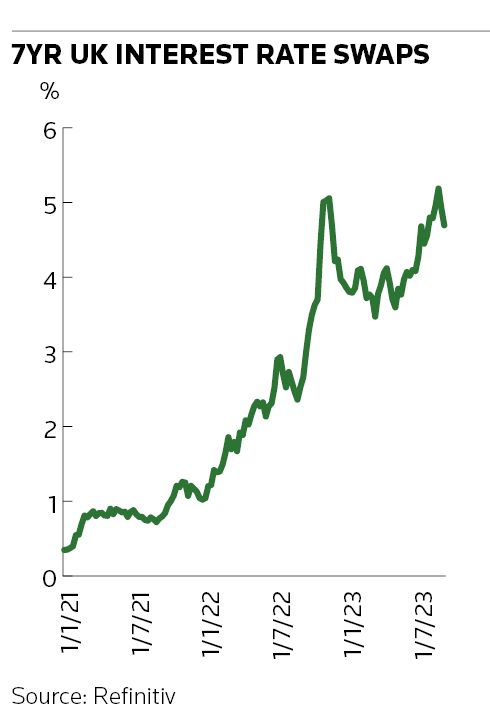The steep rise in interest rates over the past year is forcing some borrowers to accept a new rule: no hedge, no loan.
Highly indebted companies are increasingly facing requirements to hedge their interest rate risk as a pre-requisite for securing a loan, marking a departure from the banking playbook of the previous decade when a prolonged period of low rates allowed borrowers to push for more flexible lending terms.
The hedging provisions hark back to the pre-2008 financial crisis era when leveraged borrowers were routinely required to fix anything between 30% and 70% of their interest rate exposure for the first three years of a loan's life.
The past year's rapid pace of central bank hikes has encouraged banks to reinsert these obligations into loan agreements for small and mid-sized deals, typically giving companies between 30 and 90 days after the loan is drawn to put a hedge in place.
"Lenders are being more prescriptive with borrowers with regard to hedging [interest rate risk]," said Jackie Bowie, head of EMEA at consultancy Chatham Financial. "There's a lot less borrower choice as to whether they hedge or not as the lender is increasingly making hedging a condition of the loan."
The importance of hedging interest rates has returned to the fore as central banks have tightened policy aggressively to quell inflation. In one notable example, Silicon Valley Bank collapsed in March after racking up large unrealised losses on its bond portfolio, providing the clearest warning to date of the dangers of ignoring these risks.
Stricter terms
Such events have allowed lenders to impose stricter terms on companies with large amounts of debt. Fitch expects average interest burdens for unhedged floating-rate borrowers will rise to 7.5% in the European leveraged loan market – up materially from the average of 4.2% in 2020–21.
Syndicated loan investors say questions around hedging have appeared in almost every lender call in recent amend-and-extend deals, including a €5.6bn-equivalent deal by UK retailer EG Group and a €3.89bn-equivalent amend-and-extend transaction from Dutch food company Upfield.
Hedging has also started to become a pre-requisite on new loans for small and mid-sized companies. Leveraged loans above £15m typically trigger a hedging requirement across the sterling, euro and US dollar market, said Bowie.
Chris Kandel, a partner at law firm Morrison Foerster, said he has seen provisions attached to mid-market leveraged loans between US$10m and US$200m.
"If interest rates continue to rise and you haven't hedged yourself, all of a sudden you have an expense you didn't expect – which can kill your business," Kandel said. "That's why prudent people think it's a good idea to hedge because otherwise you're essentially gambling with your business."
Hedging requirements were commonplace in the leveraged loan market before the 2008 financial crisis. That mainly involved borrowers using swaps or options to fix a portion of their floating-rate debt to shield themselves against rises in interest rates.
This practice changed when global central banks pinned interest rates near to zero for most of the following decade to stoke anaemic economic growth. Borrowers successfully argued these hedging requirements were no longer needed and had them dropped from loan agreements.
"It wasn't that they stopped hedging altogether, they just managed to get the requirement to do so removed from their loan agreements," said Kandel. "There are a lot of business risks that a company deals with, so why should interest rate risk be singled out as being the greater risk than the others? That was the argument and, during a period of historic low rates and fierce competition among lenders, it worked."
Hedging back
Hedging requirements today are similar to those found in loan agreements 15 years ago, but they differ somewhat from one bank to the next. Some lenders, for instance, may stipulate borrowers hedge 65%–75% of their interest rate risk for the full term of a loan, said Bowie.
But not every bank has managed to write these provisions back into loan documents. Paul Mullen, a partner at law firm Hogan Lovells, said some borrowers argue "the horse has already bolted from the stable" when it comes to protecting themselves from rapid interest rate market movements.
"It's arguably a bit too late to reintroduce hedging requirements at this stage in the market, although prudent borrowers will be looking at their hedging strategy in any event," he said.
Still, bankers say the velocity and scale of recent interest rate moves mean these requirements will become more commonplace across capital markets. "Lenders and regulators alike are going to be taking an increased interest in making sure that [companies' exposures] to rates or inflation ... are kept within certain thresholds," said one senior rates trader. "It's in nobody's interest for any market participants to build up risks that are too large to manage."
